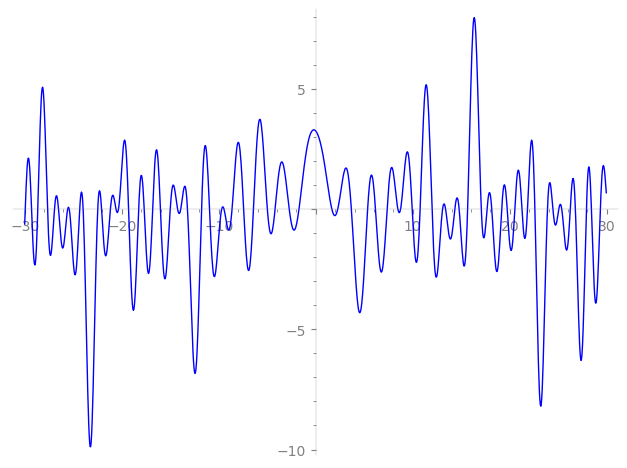| L(s) = 1 | + (3.45 + 1.99i)3-s + 6.36·5-s + (5.32 − 3.07i)7-s + (3.46 + 6.00i)9-s + (4.55 + 2.63i)11-s + (−0.635 + 12.9i)13-s + (22.0 + 12.7i)15-s + (−16.0 − 27.8i)17-s + (4.23 − 2.44i)19-s + 24.5·21-s + (−8.99 − 5.19i)23-s + 15.5·25-s − 8.25i·27-s + (−18.6 + 32.3i)29-s − 39.4i·31-s + ⋯ |
| L(s) = 1 | + (1.15 + 0.665i)3-s + 1.27·5-s + (0.760 − 0.439i)7-s + (0.385 + 0.666i)9-s + (0.414 + 0.239i)11-s + (−0.0488 + 0.998i)13-s + (1.46 + 0.847i)15-s + (−0.944 − 1.63i)17-s + (0.223 − 0.128i)19-s + 1.16·21-s + (−0.391 − 0.225i)23-s + 0.622·25-s − 0.305i·27-s + (−0.644 + 1.11i)29-s − 1.27i·31-s + ⋯ |
\[\begin{aligned}\Lambda(s)=\mathstrut & 416 ^{s/2} \, \Gamma_{\C}(s) \, L(s)\cr =\mathstrut & (0.892 - 0.451i)\, \overline{\Lambda}(3-s) \end{aligned}\]
\[\begin{aligned}\Lambda(s)=\mathstrut & 416 ^{s/2} \, \Gamma_{\C}(s+1) \, L(s)\cr =\mathstrut & (0.892 - 0.451i)\, \overline{\Lambda}(1-s) \end{aligned}\]
Particular Values
| \(L(\frac{3}{2})\) |
\(\approx\) |
\(3.15936 + 0.753553i\) |
| \(L(\frac12)\) |
\(\approx\) |
\(3.15936 + 0.753553i\) |
| \(L(2)\) |
|
not available |
| \(L(1)\) |
|
not available |
\(L(s) = \displaystyle \prod_{p} F_p(p^{-s})^{-1} \)
| $p$ | $F_p(T)$ |
|---|
| bad | 2 | \( 1 \) |
| 13 | \( 1 + (0.635 - 12.9i)T \) |
| good | 3 | \( 1 + (-3.45 - 1.99i)T + (4.5 + 7.79i)T^{2} \) |
| 5 | \( 1 - 6.36T + 25T^{2} \) |
| 7 | \( 1 + (-5.32 + 3.07i)T + (24.5 - 42.4i)T^{2} \) |
| 11 | \( 1 + (-4.55 - 2.63i)T + (60.5 + 104. i)T^{2} \) |
| 17 | \( 1 + (16.0 + 27.8i)T + (-144.5 + 250. i)T^{2} \) |
| 19 | \( 1 + (-4.23 + 2.44i)T + (180.5 - 312. i)T^{2} \) |
| 23 | \( 1 + (8.99 + 5.19i)T + (264.5 + 458. i)T^{2} \) |
| 29 | \( 1 + (18.6 - 32.3i)T + (-420.5 - 728. i)T^{2} \) |
| 31 | \( 1 + 39.4iT - 961T^{2} \) |
| 37 | \( 1 + (16.8 - 29.2i)T + (-684.5 - 1.18e3i)T^{2} \) |
| 41 | \( 1 + (15.9 - 27.6i)T + (-840.5 - 1.45e3i)T^{2} \) |
| 43 | \( 1 + (-7.50 + 4.33i)T + (924.5 - 1.60e3i)T^{2} \) |
| 47 | \( 1 - 69.4iT - 2.20e3T^{2} \) |
| 53 | \( 1 + 19.7T + 2.80e3T^{2} \) |
| 59 | \( 1 + (-80.1 + 46.2i)T + (1.74e3 - 3.01e3i)T^{2} \) |
| 61 | \( 1 + (-29.2 - 50.6i)T + (-1.86e3 + 3.22e3i)T^{2} \) |
| 67 | \( 1 + (113. + 65.4i)T + (2.24e3 + 3.88e3i)T^{2} \) |
| 71 | \( 1 + (-40.2 + 23.2i)T + (2.52e3 - 4.36e3i)T^{2} \) |
| 73 | \( 1 + 28.9T + 5.32e3T^{2} \) |
| 79 | \( 1 - 73.0iT - 6.24e3T^{2} \) |
| 83 | \( 1 - 6.44iT - 6.88e3T^{2} \) |
| 89 | \( 1 + (41.4 - 71.7i)T + (-3.96e3 - 6.85e3i)T^{2} \) |
| 97 | \( 1 + (-28.4 - 49.3i)T + (-4.70e3 + 8.14e3i)T^{2} \) |
| show more | |
| show less | |
\(L(s) = \displaystyle\prod_p \ \prod_{j=1}^{2} (1 - \alpha_{j,p}\, p^{-s})^{-1}\)
Imaginary part of the first few zeros on the critical line
−10.94791202627484019405996360093, −9.689263580282251586353151482554, −9.456807416736741993183369529090, −8.625205266252916712899431219615, −7.42961526468851606124416783923, −6.41966255352494923379943202539, −4.98690708034557967256256028455, −4.18798474572005027725676144173, −2.73101306899258896662936137632, −1.72413862177664263148488576692,
1.66160763181993918275643932167, 2.27088183282672542939517461409, 3.67217953314270100969618175092, 5.34998377038149096447862047268, 6.15670352776463894076081539042, 7.35870958205591556204174765861, 8.467702729849784133615620803432, 8.746252534253589423064176820033, 9.941296380226962711610352289396, 10.76142352963623681216932333753

